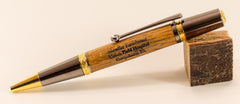War between the states
History Salvaged along with working with historic sites, museums and fraternal organizations continually search for new and exciting Witness Wood® and other materials of historic significance. Hereinbelow is a brief description of some very scarce Witness Wood® acquired by History Salvaged that is related to the American Civil War.
Due to the rarity of many these Witness Woods® and because almost ALL of our Witness Wood® pens are custom made to order, there may NOT be a listing for a specific pen or other items for certain of these woods listed in our store.
PLEASE EMAIL US - if there is a specific Witness Wood® pen or other items you are interested in!
Email Bob@HistorySalvaged.com and we will be happy to work with you to create your perfect custom pen, knife, cufflinks, or other items. Please note: History Salvaged custom handcrafted pens typically are delivered in 2 weeks for placement of your order.
Gettysburg
- Union Field Hospital – Sheaffer Farm (Blood Stained Floorboards)
- The SHEAFFER FARMHOUSE – GETTYSBURG, PA Witness Wood® Blood Stained Floor Board recently removed during maintenance was acquired by History Salvaged from the owner of this former Union Field Hospital that was inundated with causalities and where nearly 3,000 Rebel prisoners who were taken during “Pickett’s Charge” were kept during the July 1-3, 1863 Battle of Gettysburg!
- When the wounded began to arrive on the first day of battle, the Sheaffer’s were asked to leave. Immediately thereafter, surgeons began performing amputations on every available surface, forcing the drilling of holes in the floorboards to “wash the blood into the cellar”. The most famous patient at the Sheaffer House Field Hospital was General Daniel Sickles.
- Union Field Hospital – Sheaffer Farm (Beam)
- The SHEAFFER FARMHOUSE – GETTYSBURG, PA Witness Wood® Oak Beam recently removed during maintenance was acquired by History Salvaged from the owner of this former Union Field Hospital.
- General Longstreet Tree
- History Salvaged has acquired Witness Wood® from the tree at Gettysburg Battlefield known as the General Longstreet Witness Tree. History Salvaged is proud to have secured this original tree core from the tree that was growing during the Battle of Gettysburg.
- General Longstreet Witness Tree was growing in a confederate area on the original confederate battle line near the Snyder house on the Battlefield. This core piece of Witness Wood® has been obtained legally in conjunction with the Gettysburg Museum and the arborists and tree cutters.
Appomattox (McLean Surrender House)
The Appomattox Witness Wood® are several roof shingles from the “Surrender House”: the McLean House, where on Palm Sunday, April 9, 1865, General Robert E. Lee surrendered to Lieutenant General Ulysses S. Grant ending the Civil War. These cedar shingle pieces of Witness Wood® were acquired by History Salvaged after being removed and replaced during the 2-year reconstruction of the “Surrender House” from 1947-1949.
One of the first battles of the American Civil War took place on the farm of Wilmer McLean at Bull Run, VA: the First Battle of Bull Run (First Battle of Manassas). Fearing the family’s safety, Wilmer McLean relocated the family to Clover Hill, VA (renamed Appomattox Court House) 120 miles to the south.
It can be said that the Civil War started in McLean's backyard in 1861 and ended in his parlor in 1865. (Neither event, however, marked the true beginning or end of hostilities.
Jefferson Davis (Beauvoir Plantation)
The Jefferson Davis Witness Wood®, original pieces of the porch and balusters acquired by History Salvaged that were recovered and removed during the restoration and rebuilding of The Jefferson Davis Home and Presidential Library after being severely damaged by Hurricane Katrina in 2005.
Completed in 1852, Jefferson Davis while looking for a quiet retreat to write his books and papers in 1877 rented a pavilion at Beauvoir House. Falling in love with the property agreed to purchase the property and agreed on paying the $5,500 purchase price in 3 installments. Shortly after making the first payment, the owner died at which time Davis found out he was the sole heir to Beauvoir and other property.
Davis lived at Beauvoir until his death in 1889, when the house passed to his daughter and wife his wife Varna. Mrs. Davis sold Beauvoir to the Mississippi Division of the Sons of Confederate Veterans and was used as a no-charge property for Confederate Veterans and their widows until 1957 when sold with the stipulation that it was to be used as a “memorial to Jefferson Davis and the Confederate Soldier”.
“Stonewall” Jackson Prayer Tree
The General "Stonewall" Jackson Witness Wood® secured by History Salvaged is a piece of the 350-year-old tree that General “Stonewall” Jackson stopped to pray under following the end of his Shenandoah Valley campaign in May and June of 1862.
History Salvaged acquired several historic pieces of the massive oak that stood proudly on the edge of a farm field owned by Warren and Catherine Wilkerson and their family until May 27, 2011, when the diseased-weakened oak was blown down by high winds.
Dr. Mudd House
His father Thomas Mudd gave his son, Dr. Samuel A. Mudd, St. Catherine, his home and plantation in Charles Co. Maryland, on the occasion of his marriage and graduation from Baltimore Medical College around 1857.
It was at St. Catherine on the morning of Apr. 15, 1865 that Dr. Mudd assisted Abraham Lincoln assassin, John Wilkes Booth, by setting his broken leg and facilitating his escape.
Although feigning innocence, Dr. Mudd was sentenced to prison for the part he played and was subsequently pardoned by Pres. Andrew Johnson in 1869. He died in 1883.
Several Witness Wood® shingles and nails removed during restoration and sold by Dr. Mudd’s granddaughter have been acquired by History Salvaged
Dr. Mudd’s home remained in the family and in 1974 was placed on the National Register of Historic Places. It opened as a museum in 1983.
Elmira Prison (“Hellmira”, NY)
Conditions were particularly awful at "Hellmira", where sanitation and clean water was near non-existent and where most prisoners had little shelter, even in the harsh winter.
Following the end of the Civil War, lumber from the Confederate Officers quarters was used in 1866 to build 4 houses in the Town of Elmira. History Salvaged was able to acquire a collection of this original construction Witness Wood® removed during a renovation and expansion of one of the 1866 homes.
Just finding this rare 150+-year-old wood, witness to some of the seminal events at this notorious Civil War Prison Camp, where more than 25% of the 12,100+ Confederate States of America prisoners of war died, is extraordinary in itself.
Libby Prison (MD)
History Salvaged acquired at auction a unique piece of Civil War history, Witness Wood® from the infamous Confederate Libby Prison.
Libby Prison was in Richmond, Virginia and used for holding captured Union officers. As with most Civil War prisons, both Union and Confederate, Libby gained a villainous reputation for its overcrowded and harsh conditions. Prisoners suffered from disease and malnutrition leading to a high mortality rate. By 1863, one thousand prisoners were crowded into large open rooms on two floors, with open, barred windows leaving them exposed to weather and temperature extremes.
Built before the war as a food warehouse, Libby Prison was moved to Chicago in 1889 to serve as a war museum. It was dismantled in 1899, with its contents and even pieces of the building itself sold as souvenirs.








